Carnival Cruise Line Champions Inclusivity in the World of Luxury Cruising
In the exclusive world of cruising, we discover how Carnival Cruise Line has retained its position as a brand for everyone.
Launched 52 years ago, today Carnival Corporation & plc is the world’s largest leisure travel company with over 90 ships sailing under 9 diverse brands (Carnival Cruise Line, Princess Cruises, Holland America Line, Seabourn, Cunard, AIDA Cruises, Costa, P&O Cruises (UK) which includes Cunard, and P&O Cruises (Australia).
With 26 ships, Carnival Cruise Line is the company’s largest brand carrying millions of guests every year. It is the world’s the first cruise operator certified ‘Sensory Inclusive’ by KultureCity, a leading advocacy organization providing training and tools to enhance vacations for guests with Autism, ADHD, PTSD, Down Syndrome and Sensory Disabilities. We caught up with Carnival Cruise Lines VP of Hotel Refurbishment, Lisa McCabe and Petu Kummala AVP of Design & Architecture to understand their unique approach in seamlessly integrating sensory elements into the design of their ships.
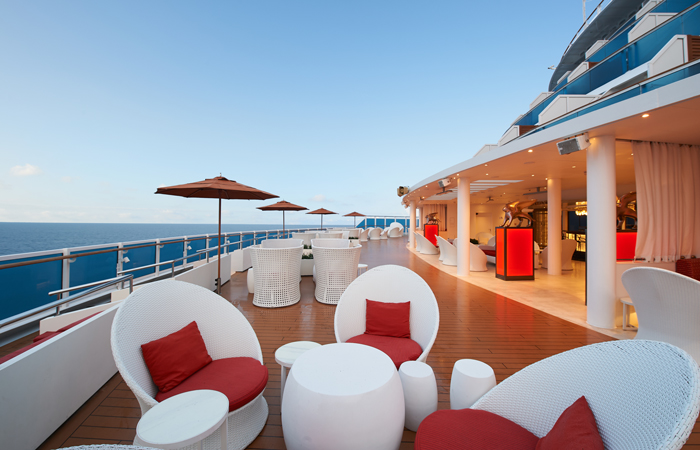
Carnival Cruise Line, Venezia, Carnevale Bar
Carnival Corporation’s portfolio of ships has such a broad reach; how do you use interior design to differentiate between your brands?
Petu Kummala AVP of Design & Architecture at Carnival Cruise Line explains, “Architecture and design plays significant role in differentiating the brands from each other.”
Launched over the past 5 years, our Excel Class of flagships on our P&O, Carnival and Aida brands are a perfect example of how to differentiate through design. The technical platform across all three brands is the same. So, the hull has the same design but the general arrangement (i.e. the facilities) and interior design offers guests a totally different experience.”
He adds, “Carnival Cruise is known for being a fun brand, and whilst design and amenities have evolved over the past 50 years, we want to retain the element of fun. Our ships are chic and elegant, but at the same time are fun and vibrant.
We have the very elegant high-end steak houses and Rudy’s Sea Grill, where you can dress up, or if you want to go casual, we have our BBQ restaurant and the Burger Joint which are very laid back but something our guests love so is a must. Carnival ships have the whole range with greater variety, whereas with Seabourn it’s all luxury and high-end. New dining concept can trickle down to existing ships. When we find something that is popular it can work across the brands, like chefs table”.
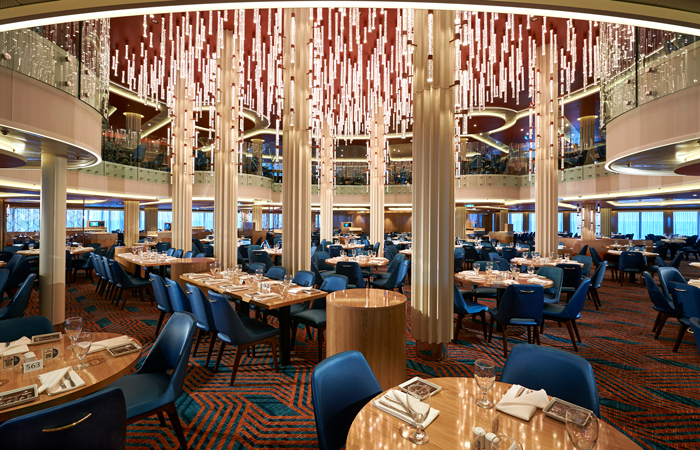
Carnival Cruise Line, Jubilee Pacific Restaurant
Carnival Cruise Lines VP of Hotel Refurbishment, Lisa McCabe adds, “Even within Carnival Cruise Line’s ships vary, as our designs reflect the needs of the guests. For example, we have Carnival Splendor that sails predominantly in Australia, where we have incorporated different needs even within the same brand. Design modifications include guests wanting to be more in the shade, so we’ve built shade structures. Food venues are a little different too. On Carnival Splendor we have Masala Tiger featuring Indian Cuisine enjoyed by our guests in Australia and we have two coffee bars. So, even within the same brand, if a ship is dedicated for a specific location there are adjustments made in design and operations to best suit our guests”.
She adds, “Carnival just rebranded two Costa ships built for the China. Built in Europe, Carnival Venezia and Carnival Firenze have been renovated and enhanced for Carnival guests sailing out of California and New York. This included adding jacuzzi areas to the USA level and more treatment rooms in our spa. We’ve also incorporated divided youth areas and exclusive branded restaurants”.
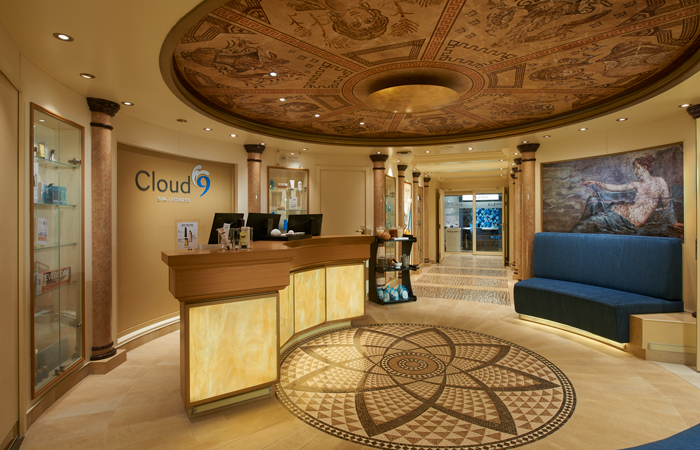
Carnival Cruise Line, Venezia, Cloud9 Spa Entrance
Explain how different design elements come into play when creating the right ambience for the diverse areas within one ship?
Petu Kummala, “We create versatile ships, incorporating quieter upscale experiences such as fine dining, but also have big pool parties and shows. Our guests are very diverse and vary in age, so we want to be sure we are offering something for everyone, regardless of age and interest.
Guests want a BBQ restaurant to a fine dining steak house and everything in between – we need to keep that in mind when designing the ships”.
Lisa McCabe, “With our casual dining areas, on some of our vessels we’re developing on from the traditional buffet line to new ideas, like creating island concepts with different cuisine choices, such as street eats in our newer ships.
The Carnival brand has been around for multi generations, so the vessel design also evolves with time. When ships were first built, the kids’ area was more like a room – – now they are themed spaces with interactive design elements. The outdoor deck area is the one thing that does vary the most from brand to brand. A Seabourn ship is not going to have a rope course, water park or rollercoaster. But on a Carnival ship you’re going to have all these activities including mini golf, big water parks, climbing walls etc”.
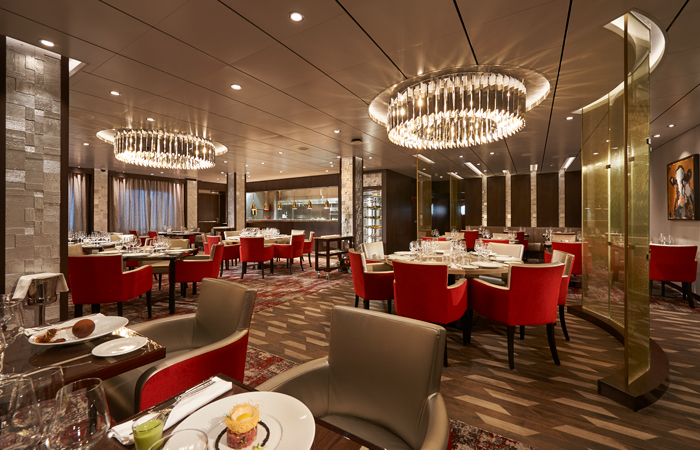
Carnival Cruise Line, Jubilee, Fahrenheit Steakhouse
Petu Kummala agrees, “Kids are more central to the experience. When I was a kid, my parents would drop me off at hockey, but now parents are there, watching every move.
We recognise it can’t all be crazy and fun – we need to have the balance, whereas other brands might not need areas to be that far apart let’s say. Our cabins are designed to be very calming places on purpose because our ships are so active, so you have your own serene spa-like haven”.
Lisa McCabe, “Retail is another area that has evolved, and Carnival is investing in both new build and refurbishment. Retail areas are becoming more exclusive where people can buy diamonds, high end jewellery, watches, and large dollar amount artwork.”
Petu Kummala, “There’s artwork that is part of the design, like a sculpture or painting, but then we also have art that is for sale in various locations with auctions to sell artwork. Carnival has less art on show compared to say a Costa, but we incorporate more sculpture within the design.
We take valuable insights from customer feedback on art, food, design and adjust to that. Entertainment is also a big part of the Carnival experience, comedy, music theatres. Again, we offer a wide variety, from dining in a jazz bar with a cocktail, to a piano or rock band in the atrium”.
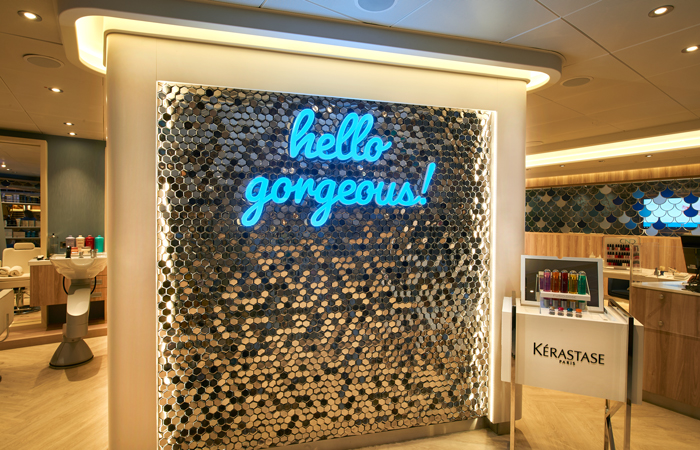
Carnival Cruise Line, Venezia, Beauty Salon Entrance
Expanding its commitment to making a cruise vacation more accessible for everyone, Carnival Cruise Line is the first cruise operator to be certified “sensory inclusive” by KultureCity. What did that involve and how has it impacted your guests and staff?
Lisa McCabe, “A main focus with ADA and our fleet is for our ships to be physically accessible to people with disabilities.”
Petu Kummala, “We even have special devices for the hearing impaired in our theatres. Carnival has always been for everyone!
That was the big idea of Ted Arison, who founded the company. His idea was that cruising shouldn’t be exclusive for certain types of people, it should be for everyone, and Carnival still has that value.
We don’t want to leave anyone behind! We want everyone to enjoy the cruise”.
Lisa McCabe adds, “We are also the first cruise line to be sensory certified. We provide kits for those with sensory sensitivities. The kits have helpful tools to help guests calm and manage the sensory overload. Our staff are trained for that. When a family books a cruise, the information is shared so our staff are prepared”.
It’s wonderful to interview a brand that has been around for over half a century, holding the same inclusive values from when it was first founded but listening and evolving to meet the needs of today’s guests.




